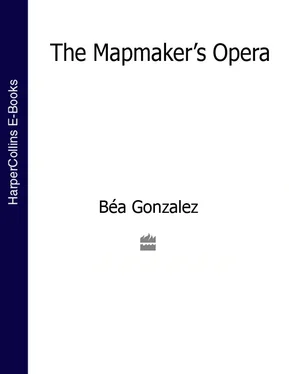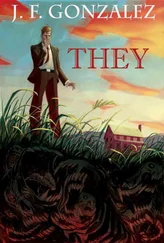In the sixteenth century, a Spanish king, Philip II, obsessed with a love of God and in need of enough gold to prove it, instructed the royal cartographers to map his kingdom. Make the invisible visible, he told them, and let every European know who reigns over the New World. Within a few short years he was dead, but through engravings and woodcuts, the cartographers continued fashioning territories, travelling the spaces they sought to make real with measuring chains, wooden goniometers, compasses and their vivid fantasies—because before a land can hope to be mapped, it must first take root in our dreams.
Diego Clemente’s map is to be read carefully, from east to west, from right to left, beginning at 5°59’W, 37°23’N—the red spot that marked his birth in Seville—and ending at 89°39’W, 20°58’N—Mérida, his final resting place.
It is a beautiful map, more beautiful yet when you consider the sorrows he must have conquered in order to leave behind this final testament of symbols, lines and grids. A man should wait until he is close to death before attempting to draw conclusions about the meaning of his life—so you once said, Abuela, and we cannot help but wonder if Diego had been furnished with the opportunity to inspect his handiwork, to reflect one final time on his journey from his beginnings in Seville until that very last day at a Mexican hacienda an ocean away.
Like Columbus, who believed the New World contained mysterious islands brimming with wondrous gardens and golden apples, Diego’s mind had a touch of the fanciful in it, a penchant for concocting magical kingdoms, for imagining perfection, for clawing at the edges of mortality, attempting to map with his quill the mystery of existence, trying to keep death and, what is more, extinction itself at bay. We pause briefly to remember those who have disappeared forever from the skies—the Carolina Parakeet, the Passenger Pigeon, the Labrador Duck—and we lament, oh how we lament, the absence of dreamers like Diego who dared to stand up to the throngs, to the beliefs and disbeliefs of his own day and age.
But the lights begin to dim now, the words of the program become harder and harder to make out. A hush falls over the audience, a sense of expectation rises until it is met at its peak by the lowering of the baton as the first notes sound out. The curtains slowly rise and we find ourselves seated before the heavenly streets of nineteenth-century Seville. Picture a city bathed in the smell of orange blossoms in spring, jasmine in the fall. Imagine the women, their long dark hair covered by lace mantillas —black or white depending on the occasion—their fiesta dresses boasting trains, ribbons, frills and polka dots. In the distance the sounds of a guitar escape from a half-opened window—a song of love and death, for as any Spaniard will tell you, any love worth having must meet with a tragic end. Imagine too the tap-tap-tap of the flamenco dancer, arms intertwined, the music evaporating like steam, for the notes will not submit themselves to transcription and the dance vanishes forever once the passion of the dancer has been fully spent. And imagine then the heat, languorous, sultry, unbearable, the kind to be escaped in the early hours of the afternoon as shutters are closed and all retire inside for the siesta —those two hours of well-needed rest.
Inside the city’s cathedral a tall, thin man with a prominent nose is hurrying towards the main door, dressed entirely in black, his ardent eyes focused on a distant horizon, his mind lost in unknown thoughts. See him? It is Emilio García—the man who will eventually marry Mónica Clemente—at this point a seminarian, though he will end his life as a humble bookseller in Seville.
It was Emilio’s knowledge of English that would bring him much of his renown in his later days and it was this knowledge that also provided the means for the fateful meeting between Mónica Clemente and himself inside the city’s great cathedral. It was here that Mónica came to say her daily prayers and it was here too that Emilio spent his mornings shepherding about the English tourists who had begun arriving in Andalucía in small numbers around this time.
Darkly dressed, sallow-skinned, large dark eyes peering out intently from beneath an unruly head of hair, the young man appeared almost cadaverous until he began to speak and then he seemed to suddenly ignite, as if a spark had entered his body and granted him the gift of life. “ Venga, venga, ” he would urge his charges, gathered dutifully by the Puerta de la Asunción. “Inside,” he would enthuse, “await paintings by Murillo, Valdés Leal, Jordaens and Zurbarán. But that, gentlemen, is not all—shrines decorated with amethysts and emeralds, gold in abundance, the precious stones of Cardinal Mendoza and silver work the likes of which you have never seen before.” And then he would wave them forward as if waiting inside that building were the keys to the heavens themselves, the enthusiasm in his voice increasing with every step until it reached a crescendo from where he would only slowly and reluctantly descend.
“Notice, if you will, the roof by Borja, señores, ” he would point out to the tourists first. “A beauty, no? A marvel to behold.”
“Ah yes, indeed,” the tourists would respond, necks stretched awkwardly upwards trying to get a good look, their efforts interrupted abruptly by Emilio, who had already moved on to other more important things.
“And before you, the sculpture of Santa Veronica by Cornejo. Yes, splendid it is. I have no words to adequately describe such works. Magnificent, tremendous. Señores, you must admit that they simply fill the heart with awe.”
“ So true, ” the English would agree, shaking their heads, eyebrows arched in wonder as their young tour guide charged earnestly ahead.
Emilio, to all appearances oblivious to those who trudged faithfully behind him, would continue to point out the delights of the cathedral. “On your right, the Virgin with the Christ, St. John and the Magdalena, all by Pedro Roldán. And, my personal favourite—notice, please, the stupendous statues and Corinthian pillars designed by Juan de Arce. Magnificent, señores, outstanding beyond compare.”
The English would nod. Ah yes, ah no, of course and indeed, they would say, walking dutifully behind the young man who would saunter ahead as if fearing the great building itself was on the verge of disappearing into thin air and it was all they could do to catch this one final glimpse of it.
Later, alone in the cramped rooms of their pensiones, it was not the ostentatious delights of the cathedral the tourists would remember, but the enthusiastic young man who had been their guide: his passion, the quickness of his stride, his facility with English, which he spoke with such flourish and drama that it seemed in some ways a totally new language.
In the evenings too, alone in his dark room at the seminary, Emilio would pore over his books, trying with all his might to block out the gaiety of Seville. The sounds and the smells drifted into his room from the streets outside as people played, sang and declared their love for each other; because there, outside, were the sounds of life, he would tell himself and, thinking this, he would sink into despair at the sight of his narrow bed, the stained walls, the brass cross hanging over his desk and even his own pale hands turning the pages of a book by the dim candlelight.
On that particular evening, Emilio was reading the poetic works of Shelley, stumbling over the words but determined to get them right for if there was one thing that Emilio loved above all it was the sound of the English language.
English—yes, it seems strange indeed that a man who had been raised speaking the sonorous language of Lope de Vega and Cervantes felt such passion for the language he often accused of driving a person mad with its incomprehensible grammatical rules and its impossible pronunciation. But Emilio had been ensnared, seduced by English words, English cadences. Even more than the language, he loved the writers: Sir Walter Scott, above all, whose novels Emilio spent hours admiring, dictionary at the ready, or the heady outpourings of the English Romantics.
Читать дальше












